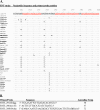Highly sensitive and broadly reactive quantitative reverse transcription-PCR assay for high-throughput detection of Rift Valley fever virus
- PMID: 17804663
- PMCID: PMC2168471
- DOI: 10.1128/JCM.00936-07
Highly sensitive and broadly reactive quantitative reverse transcription-PCR assay for high-throughput detection of Rift Valley fever virus
Abstract
Rift Valley fever (RVF) virus is a mosquito-borne virus associated with large-scale epizootics/epidemics throughout Africa and the Arabian peninsula. Virus infection can result in economically disastrous "abortion storms" and high newborn mortality in livestock. Human infections result in a flu-like illness, with 1 to 2% of patients developing severe complications, including encephalitis or hemorrhagic fever with high fatality rates. There is a critical need for a highly sensitive and specific molecular diagnostic assay capable of detecting the natural genetic spectrum of RVF viruses. We report here the establishment of a pan-RVF virus quantitative real-time reverse transcription-PCR assay with high analytical sensitivity (approximately 5 RNA copies of in vitro-transcribed RNA/reaction or approximately 0.1 PFU of infectious virus/reaction) and efficiency (standard curve slope = -3.66). Based on the alignments of the complete genome sequences of 40 ecologically and biologically diverse virus isolates collected over 56 years (1944 to 2000), the primer and probe annealing sites targeted in this assay are known to be located in highly conserved genomic regions. The performance of this assay relative to serologic assays is illustrated by testing of known RVF case materials obtained during the Saudi Arabia outbreak in 2000. Furthermore, analysis of acute-phase blood samples collected from human patients (25 nonfatal, 8 fatal) during that outbreak revealed that patient viremia at time of presentation at hospital may be a useful prognostic tool in determining patient outcome.
Figures




References
-
- Anonymous. 2000. Update: outbreak of Rift Valley Fever-Saudi Arabia, August-November 2000. Morb. Mortal. Wkly. Rep. 49:982-985. - PubMed
-
- Bird, B. H., M. L. Khristova, P. E. Rollin, T. G. Ksiazek, and S. T. Nichol. 2007. Complete genome analysis of 33 ecologically and biologically diverse Rift Valley fever virus strains reveals widespread virus movement and low genetic diversity due to recent common ancestry. J. Virol. 81:2805-2816. - PMC - PubMed
-
- Coetzer, J. A. 1977. The pathology of Rift Valley fever. I. Lesions occurring in natural cases in new-born lambs. Onderstepoort J. Vet. Res. 44:205-211. - PubMed
-
- Drosten, C., S. Gottig, S. Schilling, M. Asper, M. Panning, H. Schmitz, and S. Gunther. 2002. Rapid detection and quantification of RNA of Ebola and Marburg viruses, Lassa virus, Crimean-Congo hemorrhagic fever virus, Rift Valley fever virus, dengue virus, and yellow fever virus by real-time reverse transcription-PCR. J. Clin. Microbiol. 40:2323-2330. - PMC - PubMed
-
- Easterday, B. C., M. H. McGavran, J. R. Rooney, and L. C. Murphy. 1962. The pathogenesis of Rift Valley fever in lambs. Am. J. Vet. Res. 23:470-479. - PubMed
Publication types
MeSH terms
Substances
LinkOut - more resources
Full Text Sources
Other Literature Sources

